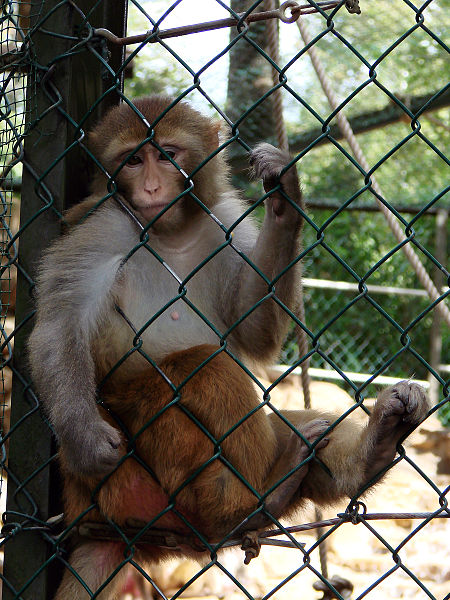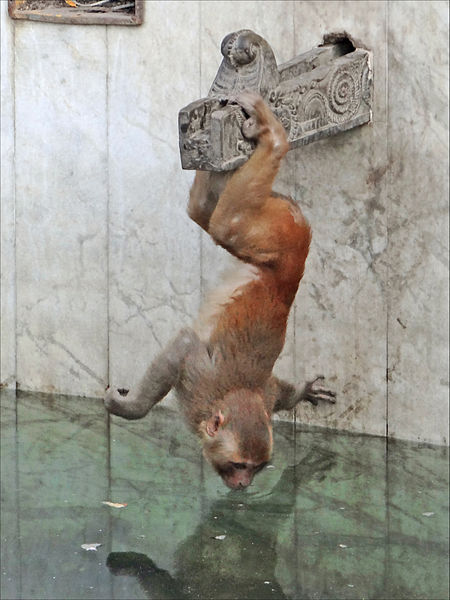
Interactions with Other Species
Rhesus monkeys are commonly kept in captivity worldwide for
medicinal and psychological research purposes because of their
genetic similarities to humans and are relatively easily maintained.
Additionally, they are common zoo animals because of their natural
curiosity and liveliness. The Rhesus monkey is rather easy to obtain
as well, as there is always a ready supply from India (Seinfeld,
2005).
from India (Seinfeld,
2005).
However, their relationship with humans does not end in captivity. The species is also known to live naturally in close proximity to human populations. So close, in fact, that a large portion of the wild monkeys rely heavily on humans for food. Some depend on direct human contact for food “donations” or handouts or rummage through garbage in urban areas. Others simply steal food from the agricultural fields and buildings maintained by humans (Lang, 2005). Naturally, this negatively affects the crop yield of farmers in the region that the Rhesus monkey inhabits; yet not much is done to prevent this thievery. This is because the species is considered a sacred animal by the Hindu religion (Seinfeld, 2005).
Rhesus monkeys are omnivores, meaning they consume just about anything that they can to feed themselves. The species is known to be very adaptable, and is incredibly resourceful when it comes to searching for food. In areas that are more isolated from human impact, the monkeys eat just about anything they can get their hands on. They focus on fruits, flowers, leaves, and seeds. However, they are known to supplement their diet with insects and even the occasional small mammal. When times are rough, these monkeys can even survive by living off of evergreen tree leaves and simple tree bark (Lang, 2005).
 There is a wide array of potential predators for these animals.
Although the populations that live near and within areas are
relatively sheltered from most predators by the human masses, the
isolated groups have a lot to worry about. Birds of prey, such as
the
peregrine falcon, and dogs
are the most prominent predators of the Rhesus monkey. However,
larger
carnivores like
tigers, crocodiles,
big cats (like the
leopard and
snow leopard) and even sharks (such as the
bull and
great white sharks) can also hunt
them! The wide spectrum of predators that harass the Rhesus monkey
proves just how adaptable the species is to many different habitats
and food supplies (Lang, 2005).
There is a wide array of potential predators for these animals.
Although the populations that live near and within areas are
relatively sheltered from most predators by the human masses, the
isolated groups have a lot to worry about. Birds of prey, such as
the
peregrine falcon, and dogs
are the most prominent predators of the Rhesus monkey. However,
larger
carnivores like
tigers, crocodiles,
big cats (like the
leopard and
snow leopard) and even sharks (such as the
bull and
great white sharks) can also hunt
them! The wide spectrum of predators that harass the Rhesus monkey
proves just how adaptable the species is to many different habitats
and food supplies (Lang, 2005).
Macaca mulatta is
linked with humankind in more way than one. Although they have their
share of natural food sources and predators, they are widely
recognized for their ability to live off of human society. The
research benefits that have come from the study of these animals are
invaluable. They are being enjoyed in zoos around the world. They
are
even considered sacred by a major religion! The Rhesus monkey has truly adapted well to the human
population expansion.